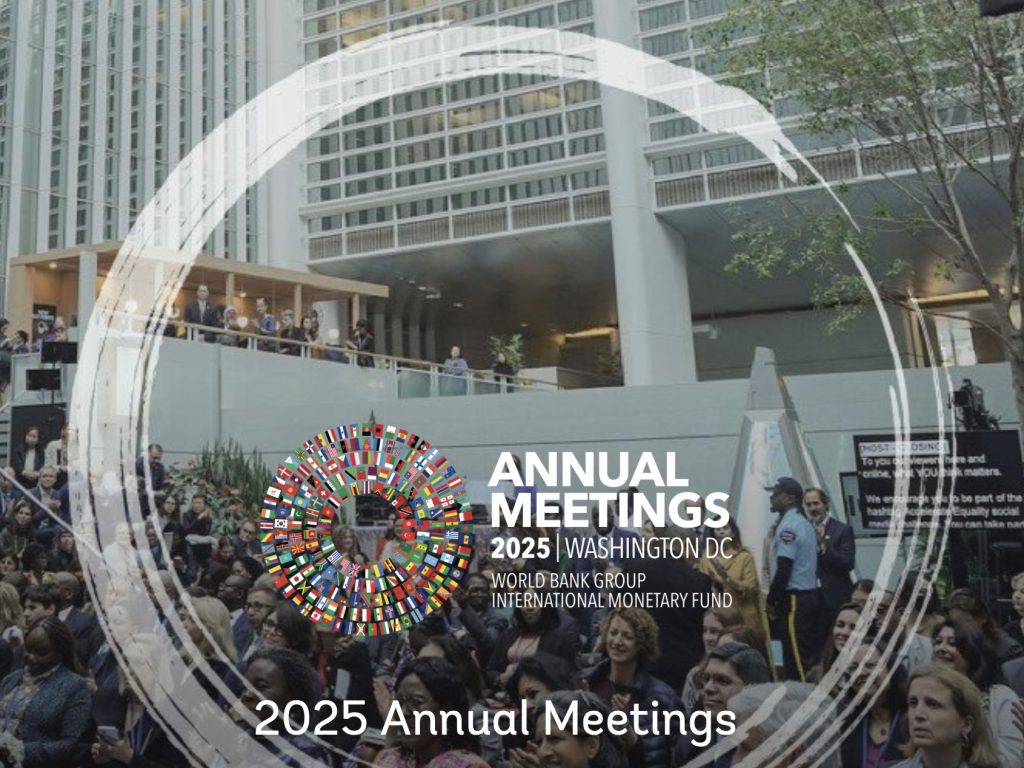From Resilience to Renewal: What Lies Ahead for the Global Economy
The 2025 Annual Meetings of the International Monetary Fund and the World Bank Group in Washington D.C. marked a turning point in the post-pandemic economic cycle. The mood was cautiously confident, shaped by evidence that the global economy has withstood a series of shocks – ranging from geopolitical tensions to high interest rates – better than many had anticipated.
However, beneath this surface stability lies a clear warning: the global system remains stretched, with elevated debt, uneven growth and deepening structural divides between economies that are adapting to technological change and those that are not. Policymakers left Washington aware that the task ahead is to sustain recovery without sowing the seeds of the next crisis.
The Core Messages
Several unifying themes emerged from the week of high-level meetings and technical sessions.
First, resilience is real but fragile. The IMF’s latest World Economic Outlook upgraded global growth for 2025 to around 3.2 percent, citing stronger-than-expected investment in technology and services. Yet, this improvement remains modest by historical standards and heavily concentrated in a few large economies.
Second, inflation is easing but still uneven. Price pressures have fallen sharply from their 2022 peaks, but services inflation and wage growth remain sticky. Central banks signaled that they will ease interest rates only cautiously and data-dependently, to avoid reigniting inflationary expectations.
Third, financial vulnerabilities are building below the surface. The rapid expansion of private credit and other non-bank financial activities has created a parallel financial system that remains lightly regulated. IMF officials noted that even a mild downturn could expose liquidity mismatches and trigger contagion through global markets.
Fourth, geopolitics has become an economic variable. The re-emergence of trade restrictions and technology-based rivalries between major powers—most notably the United States and China—has created a more fragmented and uncertain global landscape. Supply chains are adjusting, but the cumulative impact of these disruptions could dampen trade and investment if tensions deepen.
Finally, technology and inequality are now intertwined. Artificial intelligence, digital public infrastructure, and automation are transforming productivity, but the benefits are highly uneven. The IMF and World Bank called for stronger digital readiness and governance frameworks, especially in emerging and low-income economies, to avoid deepening divides in income and opportunity.
The Global Economic Outlook for the Coming Year
The overarching narrative for 2025 and 2026 is one of soft landing with shallow momentum. The global economy is expected to grow just above three percent, supported by resilient consumer spending and ongoing business investment in technology. The United States remains the primary growth engine, while the euro area faces slower and more uneven recovery due to weaker domestic demand and tight financing conditions.
Emerging markets are expected to post moderate growth, but high borrowing costs and limited fiscal space will constrain their ability to stimulate activity. Inflation should continue to decline, although lingering energy and food price volatility could cause temporary reversals.
Interest-rate cuts in advanced economies are likely to begin in the second half of 2025. However, monetary authorities will move gradually, wary of reigniting inflation. In contrast, several emerging markets that raised rates earlier are already in the process of modest easing, aiming to balance growth support with exchange-rate stability.
Risks on the Horizon
The optimism in Washington was tempered by four main risk factors that could derail the outlook.
The first is financial fragility. Global debt has reached historic highs, leaving many governments and corporations vulnerable to even small shifts in market sentiment. A sudden repricing of risk – particularly in private credit markets – could trigger volatility in both advanced and emerging economies.
The second is geopolitical escalation. Renewed trade tensions, restrictions on technology exports, or energy-supply disruptions could undermine growth and reignite inflation.
The third is inequality of recovery. Advanced economies have regained much of their lost output, but lower-income countries are still struggling with scarring effects from the pandemic and limited fiscal space. The divergence in economic performance could feed political instability and weaken global cooperation.
The fourth is the technological divide. While AI and digital technologies are fueling new growth in some economies, others risk being left behind. The IMF warned that without targeted investment in skills, digital infrastructure, and regulation, technological progress could widen gaps in productivity and living standards.
Policy Directions and Global Priorities
The meetings converged around a few practical priorities for the months ahead.
First, rebuild fiscal buffers while growth persists. Policymakers were urged to consolidate gradually but credibly, prioritizing efficiency in spending and improving revenue collection. Public finances must regain resilience before the next shock arrives.
Second, modernize financial oversight. Regulators should extend monitoring beyond banks to capture non-bank intermediaries and private credit funds that now play a major role in global finance.
Third, invest in the foundations of future growth. The World Bank emphasized financing for climate resilience, digital infrastructure, and human capital. The IMF added that digital public goods and AI-readiness policies are the new frontier of competitiveness.
Fourth, maintain open trade and multilateral cooperation. Fragmentation risks are rising, but global challenges—climate, technology, debt sustainability require coordinated solutions. Both institutions called for renewed dialogue, particularly between major economies.
Fifth, ensure inclusive and sustainable growth. Development policies must combine climate adaptation, job creation, and social protection to prevent reform fatigue and maintain political cohesion.
Looking Ahead
The global economy is entering a new phase. The emergency era of crisis response is ending, replaced by the slower, harder work of rebuilding resilience. The coming year will test policymakers’ ability to navigate between necessary caution and overdue reform.
If the soft landing holds, 2025 could mark the start of a more stable global cycle though one that grows more slowly and under tighter constraints. The risk of complacency is real, but so is the potential for renewal. With credible policies, stronger cooperation, and focused investment in technology and human capital, the global economy can turn fragile resilience into durable progress.
Source: https://meetings.imf.org/en/2025/Annual
https://www.worldbank.org/en/meetings/splash/annual/overview
- By Strategers

